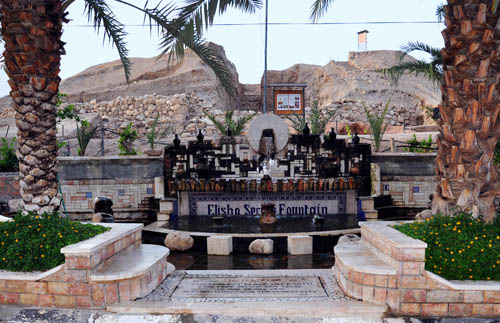Since the excavations of Tell es-Sultan by Kathleen Kenyon (1952-1958), Jericho has publicized itself as the oldest city in the world. Kenyon thought she had found the earliest known fortifications.
Tell es-Sultan has been neglected as a tourist site over the years. In May I was pleased to see that the site had been cleaned up a bit with clearly marked paths and new signs. One new thing I saw was a fountain marked as “Elisha Spring Fountain.” It is probably the same water one would find in the toilet [for those who have not traveled outside the USA, that is a Restroom].
Elisha’s Spring is on the east side of the tell. See our earlier post here. But, back to the 10,000 years. The mosaic in front of the fountain touts Jericho as “the lowest place on earth” and “10,000 years old.” In fact, Jericho is about 82o feet below sea level (Encyclopaedia Judaica, 2nd ed., Vol. 11).
The Palestinian Prime Minister held his weekly Cabinet meeting at Jericho Sunday “to mark the town’s birthday.” Authorities said the choice of October 10, 2010 (10-10-10) was random.
Biblical Jericho attracts a steady flow of pilgrims, but the small Jordan Valley oasis is making a major push these days to become a magnet for tourists, presenting itself as the oldest city on earth. Marking the 10,000th birthday Sunday is entirely random, though, with archaeologists saying they could be off by hundreds of years in dating the first human settlement in the area.
Read the complete article, which is mostly about Hisham’s Palace from the 8th century A.D., here.
One Sunday my wife and I were eating with an attorney and his wife. Through the window we could see the sign of the restaurant next door. It said something about serving the world’s best chicken. I asked my friend about the legality of signs like that. He said it was “acknowledged puffery.” I suspect we should view the signs at Jericho, and a lot of other places, in the same light.
Todd Bolen has a post about this subject, with additional photos, on the Bible Places Blog here.



You must be logged in to post a comment.